1993 CHEVROLET SUBURBAN recommended oil
[x] Cancel search: recommended oilPage 212 of 386
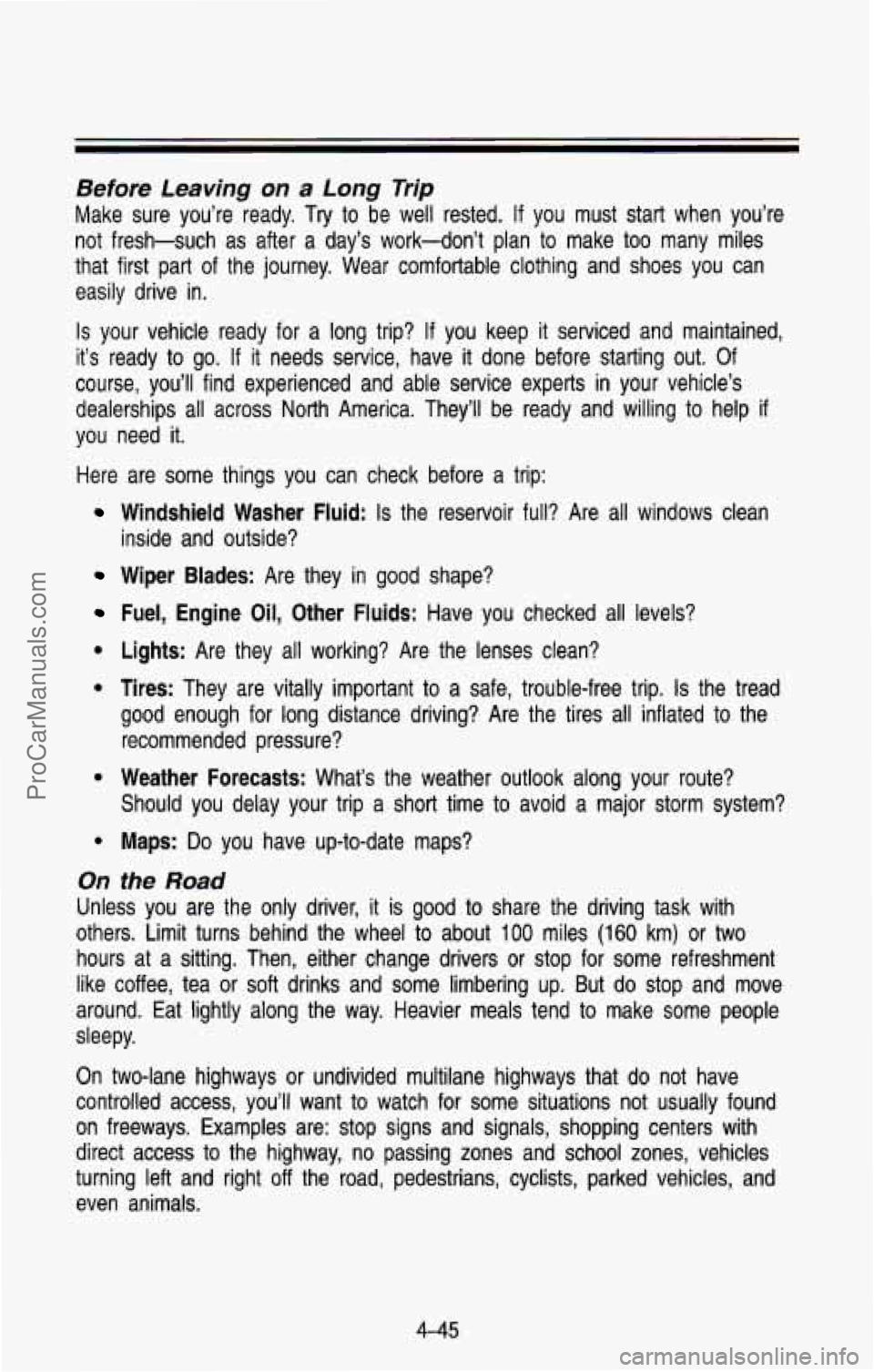
Before Leaving on a Long Trip
Make sure you’re ready. Try to be well rested. If you must start when you’re
not fresh-such as after a day’s work-don’t plan to make too many miles
that first part of the journey. Wear comfortable clothing and shoes you can
easily drive in.
Is your vehicle ready for a long trip? If you keep it serviced and maintained,
it’s ready to go. If it needs service, have it done before starting out. Of
course, you’ll find experienced and able service experts
in your vehicle’s
dealerships all across North America. They’ll be ready and w\
illing to help
if
you need it.
Here are some things you can check before a trip:
e
e
On
Windshield Washer Fluid: Is the reservoir full? Are all windows clean
inside and outside?
Wiper Blades: Are they in good shape?
Fuel, Engine Oil, Other Fluids: Have you checked all levels?
Lights: Are they all working? Are the lenses clean?
Tires: They are vitally important to a safe, trouble-free trip. Is the tread
good enough for long distance driving? Are the tires all inflated to the
recommended pressure?
Weather Forecasts: What’s the weather outlook along your route?
Should you delay your trip a short time to avoid a major storm system?
Maps: Do you have up-to-date maps?
the Road
Unless you are the only driver, it is good to share the driving task with
others. Limit turns behind the wheel to about
100 miles (160 km) or two
hours at a sitting. Then, either change drivers or stop for s\
ome refreshment
like coffee, tea or soft drinks and some limbering up. But do stop and move
around. Eat lightly along the way. Heavier meals tend
to make some people
sleepy.
On two-lane highways or undivided multilane highways that do not have
controlled access, you’ll want to watch for some situations not usually found
on freeways. Examples are: stop signs and signals, shopping cen\
ters with
direct access to the highway, no passing zones and school zones, vehicles
turning left and right
off the road, pedestrians, cyclists, parked vehicles, and
even animals.
4-45
ProCarManuals.com
Page 243 of 386

antifreeze at the coolant recovery tank. (See “Coolant” i\
n the Index for more information about the proper coolant mix.)
Adding only plain water to your cooling system can be dangerou\
s. Plain water,
or some other liquid like alcohol, can boil before the
proper coolant mix will. Your vehicle’s coolant warning system is set
for the proper coolant mix. With plain water
or the wrong mix, your
engine
could get too hot but you wouldn’t get the overheat warning.
Your engine could catch fire and you or others could be burned. Use
a 50150 mix of clean water and a proper antifreeze. I I
NOTICE I
In cold weather, water can freeze and crack the engine. radiator, heater
I core and other parts. Use the recommended coolant.
1
1 ::.
L.
k’
II
PO206
CAUTION
- = -
You can be burned if you spill coolant on hot engine parts. Coolant
contains ethylene glycol
and it will burn if the engine parts are hot
enough. Don’t spill coolant on
a hot engine.
When the coolant in the coolant recovery
is at or above COLD, start your
vehicle.
5-1 2
ProCarManuals.com
Page 300 of 386
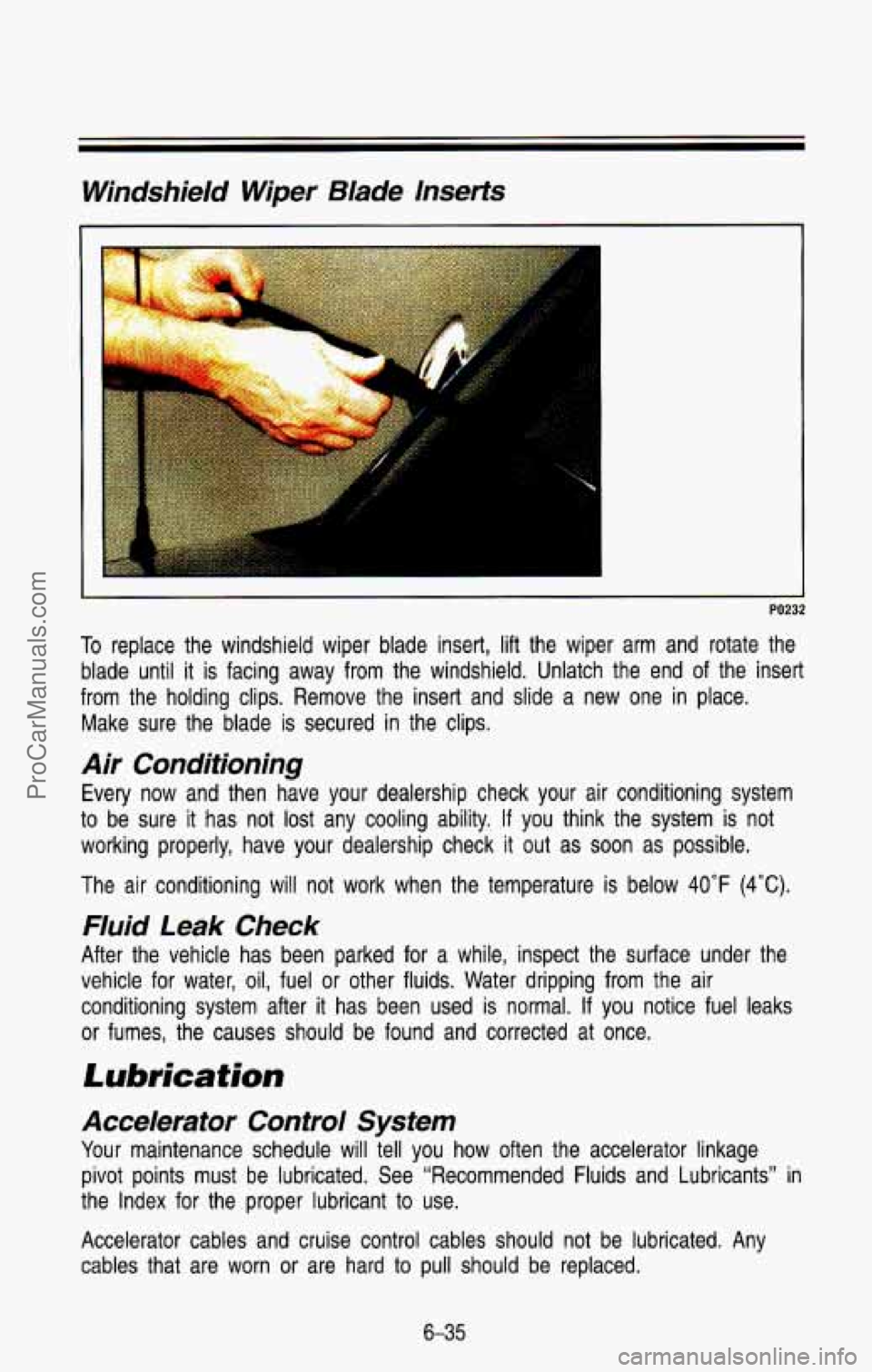
Windshield Wiper Blade lnserfs
J
PO232
To replace the windshield wiper blade insert, lift the wiper arm and rotate the
blade until
it is facing away from the windshield. Unlatch the end of the insert
from the holding clips. Remove the insert and slide a new one in place,
Make sure the blade
is secured in the clips.
Air Conditioning
Every now and then have your dealership check your air conditioning system
to be sure it has not lost any cooling ability,
If you think the system is not
working properly, have your dealership check
it out as soon as possible.
The air conditioning will not work when the temperature is below
40°F (4°C).
Fluid Leak Check
After the vehicle has been parked for a while, inspect the su\
rface under the
vehicle for water, oil, fuel or other fluids. Water dripping from the air
conditioning system after
it has been used is normal. If you notice fuel leaks
or fumes, the causes should be found and corrected at once.
Lubrication
Accelerator Control System
Your maintenance schedule will tell you how often the accelerator linkage
pivot points must be lubricated. See “Recommended Fluids and Lubric\
ants”
in
the Index for the proper lubricant to use.
Accelerator cables and cruise control cables should not be lubr\
icated. Any
cables that are worn or are hard to pull
should be replaced.
6-35
ProCarManuals.com
Page 301 of 386
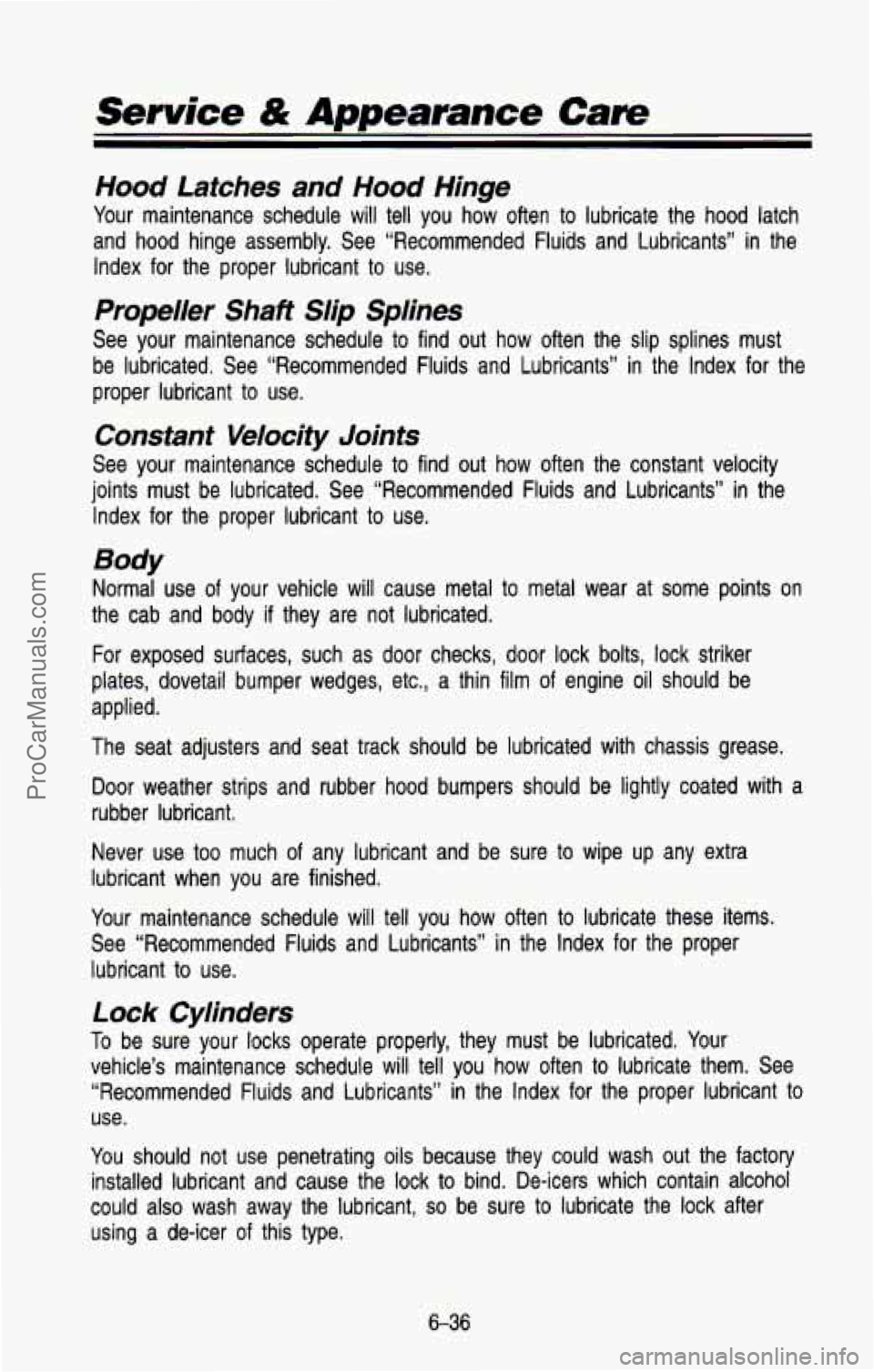
Service & Appearance Care
Hood Laiches and Hood Hinge
Your maintenance schedule will tell you how often to lubricate the hood latch
and hood hinge assembly. See “Recommended Fluids and Lubrican\
ts” in the
Index for the proper lubricant to use.
Propeller Shaft Slip Splines
See your maintenance schedule to find out how often the slip \
splines must
be lubricated, See “Recommended Fluids and Lubricants” in the Index for the
proper lubricant to use.
Constant Velocity Joints
See your maintenance schedule to find out how often the consta\
nt velocity
joints must be lubricated. See “Recommended Fluids and Lubricants”\
in the
Index for the proper lubricant to use.
Body
Normal use of your vehicle will cause metal to metal wear at some points on
the cab and body
if they are not lubricated.
For exposed surfaces, such as door checks, door lock bolts, lo\
ck striker
plates, dovetail bumper wedges, etc., a thin film of engine oil should be
applied.
The seat adjusters and seat track should be lubricated with ch\
assis grease, Door weather strips and rubber hood bumpers should be lightly \
coated with a
rubber lubricant.
Never use too much of any lubricant and be sure to wipe up any extra
lubricant when you are finished.
Your maintenance schedule will tell you how often to lubricate these items.
See “Recommended Fluids and Lubricants” in the Index
for the proper
lubricant to use.
Lock Cylinders
To be sure your locks operate properly, they must be lubricated, Your
vehicle’s maintenance schedule will tell you how often
to lubricate them. See
“Recommended Fluids and Lubricants”
in the Index for the proper lubricant to
use.
You should not use penetrating oils because they could wash out the factory
installed lubricant and cause the lock to bind. De-icers which contain alcohol
could also wash away the lubricant,
so be sure to lubricate the lock after
using a de-icer
of this type.
6-36
ProCarManuals.com
Page 327 of 386

Protecting Exterior Bright Metal Parts
Bright metal parts should be cleaned regularly to keep their l\
uster. Washing
with water is all that is usually needed. However, you may use
GM Chrome
Polish on chrome or stainless steel trim,
if necessary.
Use special care with aluminum trim.
To avoid damaging protective trim, never
use auto or chrome polish, steam or caustic soap
to clean aluminum. A
coating of wax, rubbed to a high polish, is recommended for all bright metal
parts.
Aluminum Wheels (If So Equipped)
Your aluminum wheels have a protective coating similar to the painted surface
of your vehicle. Don’t use strong soaps, chemicals, chrome polis\
h, or other
abrasive cleaners on them because you could damage this coating\
. After
rinsing thoroughly, a wax may be apptied.
NOTICE 1
f you have aluminum wheels, don’t use an automatic vehicle wash that
?as hard silicon carbide cleaning brushes. These brushes can take
off the
xotective coating.
White Sidewall Tires
Your General Motors dealer has a GM White Sidewall Tire Cleaner. You can
use a stiff brush with
it.
Weatherstrips
These are places where glass or metal meets rubber. Silicone g\
rease there
will make them last longer, seal better, and not stick or squeak. Apply silic\
one
grease with a clean cloth at least eve@ six months.
Sheet Metal Damage
If your vehicle is damaged and requires sheet metal repair or replacement,
make sure the body repair shop applies anti-corrosion material
to the parts
repaired or replaced
to restore corrosion protection.
Foreign Material
Calcium chloride and other salts, ice melting agents, road oil \
and tar, tree
sap, bird droppings, chemicals from industrial chimneys, and 0the.r foreign\
matter can damage your vehicle’s finish
if they remain on painted surfaces.
Use cleaners that are marked safe for painted surfaces for the\
se stains.
Finish Damage
Any stone chips, fractures or deep scratches in the finish should be repaired
right away. Bare metal will corrode quickty and may develop into a major
repair expense.
6-62
ProCarManuals.com
Page 359 of 386

Scheduled Maintenance Services
When the wheels are removed for rotation, inspect disc brake p\
ads for wear
and rotors for surface condition.
Also inspect drum brake linings for wear and
cracks. Inspect other brake parts, including drums, wheel cylind\
ers, parking
brake, etc., at the same time. Remove any rust
or dirt from the wheel and
mounting surfaces before mounting the wheel.
Inspect brakes more often if driving habits or conditions result in
frequent braking.
Owner Checks and Services
Listed below are owner checks and services which should be made at the
time period specified to help ensure proper safety, emission pe\
rformance, and
dependability of your vehicle.
Be sure any necessary repairs are completed at once. Whenever \
any fluids
or lubricants are added to your vehicle, make sure they are the proper ones,
as shown in this Section.
At Least Once a Month
Tire inflation pressure check --Check the tires for proper inflation. If they
are low, inflate them to the level specified on the certification label
or on the
tire inflation charts. See “Loading Your Vehicle” or “Inflation-Tire Pressure” in
the Index.
At Least Once a Year
Key lock cylinder lubrication --Lubricate key lock cylinders with engine oil.
See the “Recommended Fluid and Lubricants” chart in this section.
Transmission neutral or clutch start switch operation
4 When you are doing this check, the vehicle could move suddenly. If
it does, you or others could be injured. Follow the steps below. I
1. Before you start, be sure you have enough room around the veh\
icle.
2. Firmly apply both the manual parking brake and the regular bra\
ke. See
“Brakes” and “Parking Brake” in the Index.
Do not use the accelerator
pedal.
3. Be ready to turn off the engine immediately if it starts.
4. On automatic transmission vehicles, try to start the engine in each gear.
The starter should work only in
P (Park) or N (Neutral).
7-22
ProCarManuals.com
Page 362 of 386
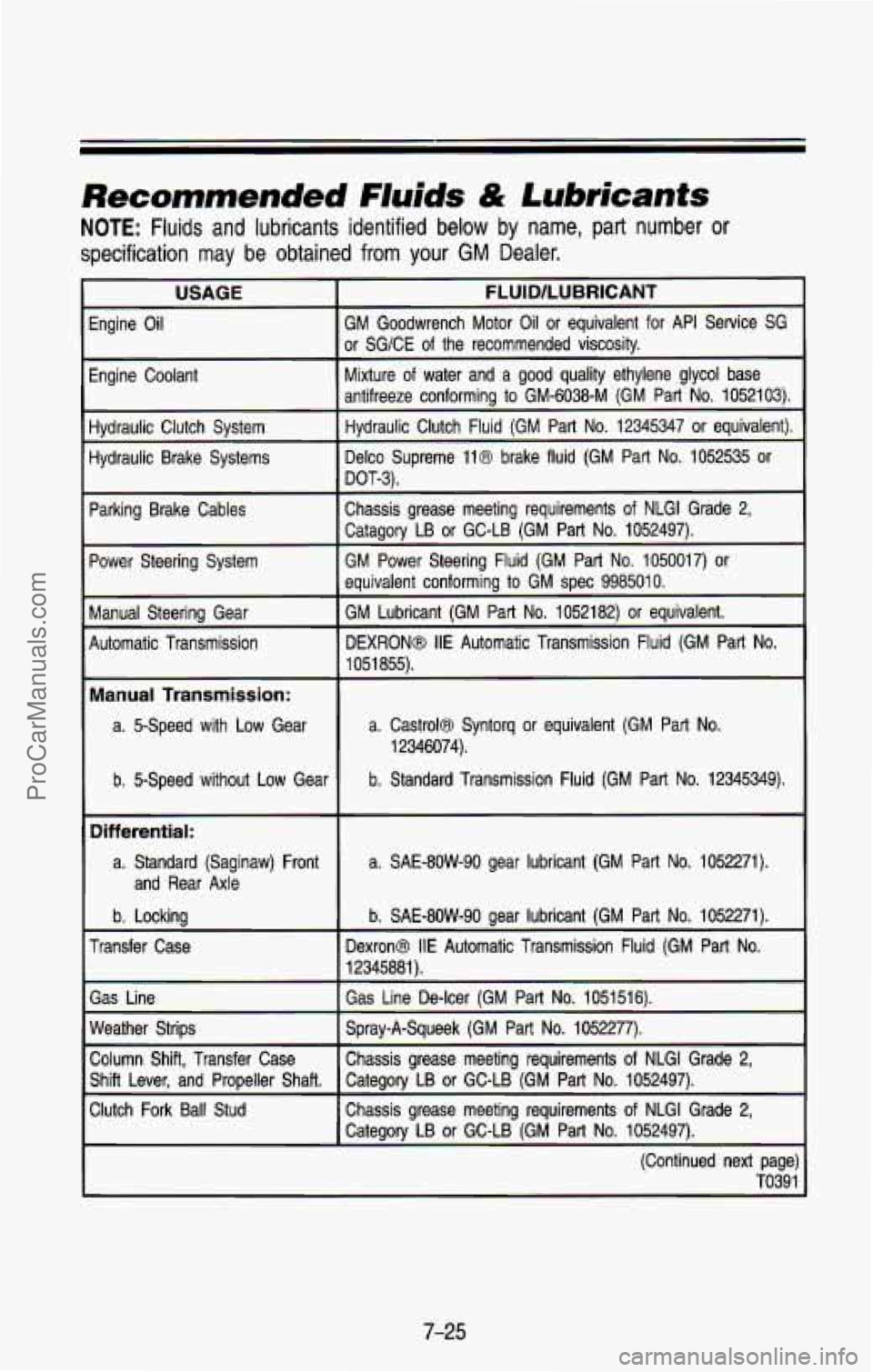
Recommended Fluids & Lubricants
NOTE: Fluids and lubricants identified below by name, part number or
specification may be obtained from your GM Dealer.
Engine Oil
IEnginelant
II
Hydraulic Clutch System
Hydraulic Brake Systems
Parking Brake Cables
(
(
Power Steering System (
t
Manual Steering Gear
Automatic Transmission
r
Manual Transmission:
a. 5-Speed with Low Gear
1 b. 5-Speed without Low Gear
I
FLUID/LUBRICANT
;M Goodwrench Motor Oil or equivalent for API Service SG
)r SGiCE of the recommended viscosity.
ilixture
of water and a good quality ethylene glycol base
intifreeze conforming to
GM-6038-M (GM Part No. 1052103).
iydraulic Clutch Fluid
(GM Part No. 12345347 or equivalent).
lelco Supreme 11
8 brake fluid (GM Part No. 1052535 or
2hassis grease meeting requirements
of NLGl Grade 2,
2atagory LB or GC-LB (GM Part
No. 1052497).
3iM Power Steering Fluid (GM Part No. 1050017) or
2quivalent conforming to
GM spec 9985010.
3M Lubricant (GM Part No. 1052182) or equivalent.
IEXRON@ IIE Automatic Transmission Fluid (GM Part No.
1051 855). lOT-
3).
a. CastrolCo
Syntorq or equivalent (GM Part No.
b. Standard Transmission Fluid (GM Part No. 12345349). 12346074).
Differential:
a.
Standard (Saginaw) Front
and Rear Axle
I
b. Locking
Transfer Case a. SAE-80W-90 gear lubricant (GM Part
No. 1052271).
b.
SAE-80W-90 gear lubricant (GM Part No. 1052271).
DexronB
IIE Automatic Transmission Fluid (GM Part No.
12345881 ).
IGas- IL
Weather Strips I:
?as Line De-leer (GM Part No. 1051516).
Spray-ASqueek (GM Part No. 1052277).
Column Shift, Transfer Case Shift Lever, and Propeller Shaft.
Clutch Fork Ball Stud
(
(
>hassis grease meeting requirements of NLGl Grade 2,
;ategory LB or GC-LB
(GM Part No. 1052497).
zhassis grease meeting requirements
of NLGl Grade 2,
;ateaorv LB or GC-LB (GM Part No. 1052497).
(Continued next page) TO391
7-25
ProCarManuals.com
Page 363 of 386
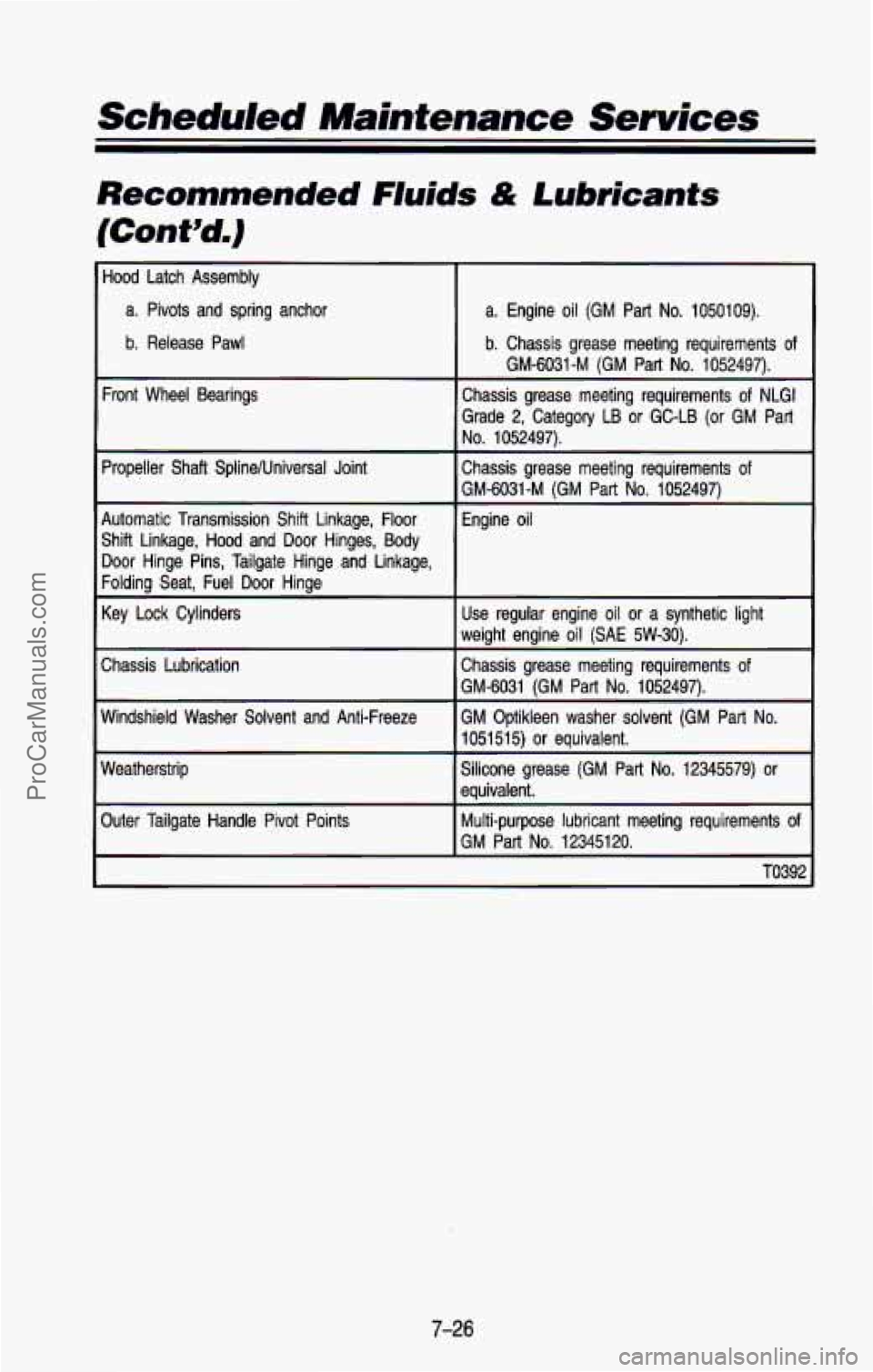
Scheduled Maintenance Services
Recommended Fluids & Lubricants
(Cont’d.)
Hood Latch Assembly
a. Pivots and spring anchor b. Release Pawl
Front Wheel Bearings
Propeller
Shaft SplinelUniversal Joint
Automatic Transmission Shift Linkage, Floor
Shift Linkage,
Hood and Door Hinges, Body
Door Hinge Pins, Tailgate Hinge and Linkage,
Folding Seat, Fuel Door Hinae Key Lock Cylinders
Chassis Lubrication
Nindshield Washer Solvent and Anti-Freeze
Neatherstrip
Mer Tailgate Handle Pivot Points a. Engine
oil (GM Part
No. 1050109).
b. Chassis grease meeting requirements
of
GM-6031-M (GM Part No. 1052497).
Chassis grease meeting requirements
of NLGl
Grade 2, Category
LB or GC-LB (or GM Part
No. 1052497).
Chassis grease meeting requirements
of
GM-6031-M EM Part No. 10524971
Engine oil
Use regular engine
oil or a synthetic light
weiaht enaine
oil [SAE 5W-30).
Chassis grease meeting requirements
of
GM-6031 (GM Part No. 1052497).
GM Optikleen washer solvent
(GM Part No.
1051515) or equivalent.
Silicone grease
(GM Part No. 12345579) or
equivalent.
Multi-purpose lubricant meeting requirements
of
GM Part No. 123451 20.
TO392
7-26
ProCarManuals.com